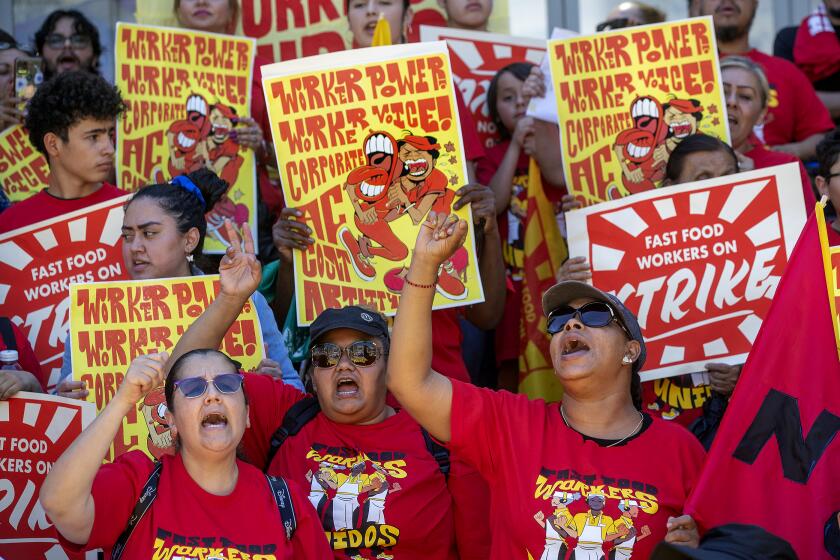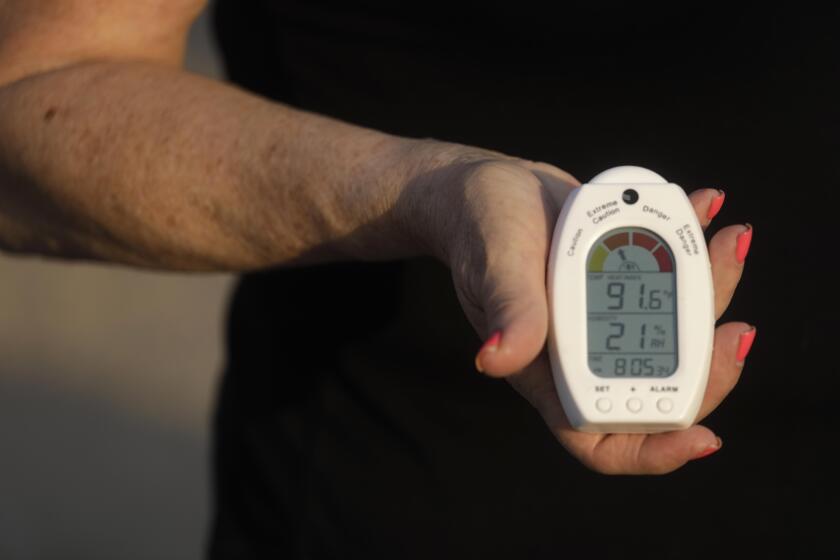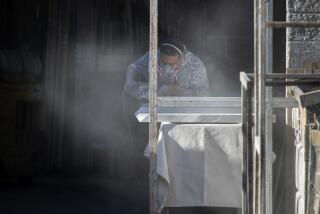California’s long-awaited indoor heat standard has gone into effect. Here’s what to know

- Share via
More than a million workers laboring in warehouses, kitchens, laundry rooms and other hot indoor settings across California are now protected by new safety measures that went into effect on Tuesday.
The indoor heat illness prevention rule, adopted by the standards board at the California Division of Occupational Safety and Health last month, regulates indoor workplaces that reach or surpass 82 degrees.
After years of delays, labor leaders celebrated the implementation of the rule. They had pressed in recent weeks for a mandated legal review of the rule to be expedited in order to get the protections in place as early on in the summer as possible.
“[W]e are relieved that the indoor heat protections are now finally in effect in California,” said Lorena Gonzalez, head of the California Labor Federation, in a statement Wednesday. “This long-overdue victory for workers cannot be overstated; these protections from extreme heat will save countless lives.”
Here’s what you should know about the new rule:
What are the new protections?
The new safety measures require employers to provide water, cooling areas and monitoring of workers for signs of heat illness whenever indoor workplace temperatures reach or surpass 82 degrees.
If temperatures climb to 87 degrees, or workers are required to work near hot equipment, employers must cool the work site. If doing so is not feasible, they must allow for more breaks, rotate workers out of hot environments and make other adjustments.
Designated cool-down areas are supposed to be as close as possible to where employees are working, and large enough that workers can sit normally without touching each other. They must be blocked from direct sunlight and shielded from heat sources, with adequate ventilation and cooling.
Drinking water must be available in multiple locations and should be “fresh, pure, suitably cool, and provided to workers free of charge,” the new rule says.
In guidance Cal/OSHA officials issued to employers, supervisors are advised to taste the water and pour it on their skin to check that it is adequate.
Employers should remind and encourage workers to drink water frequently in training sessions as well as throughout the work day, as workers “may not feel how urgently their bodies need water,” according to Cal/OSHA guidance.
Under the new rule, employers are required to allow workers to take cool-down rests if they feel they need to protect themselves from overheating.
“Waiting until symptoms appear before taking a cool-down rest may be too late,” Cal/OSHA guidance says.
More details about the indoor heat standard are available on Cal/OSHA’s website. The safeguards are similar to an existing rule establishing regulations for workers in outdoor settings.
Which workers are covered by the new rule?
The indoor heat standard applies to most workplaces. The state estimates the new rule will apply to about 1.4 million people who work indoors in conditions that can easily become exposed to extreme heat. Industries anticipated to be most affected include warehouses, manufacturing and restaurants.
The indoor heat rule does not apply to correctional staff or inmate workers in prisons, local detention facilities, and juvenile facilities.
The Department of Corrections and Gov. Gavin Newsom’s administration are in the process of consulting with worker advocates to create a separate indoor heat rule for these facilities. It is unclear how long it will take to develop and implement those protections.
The newly implemented rule also does not apply to employees who are working remotely from places not under the control of their employer.
Relief is on the horizon for California workers operating in hot, indoor settings as new protections against excessive heat were passed by a state agency.
What happens if an employer doesn’t follow the heat rule?
Workers who believe their workplaces are not adequately protecting them from extreme heat conditions can file a complaint with Cal/OSHA online or by calling (833) 579-0927.
It’s possible, however, that enforcement will be slow. California agencies responsible for enforcing labor laws have also been beset by inadequate staffing and claims of ineffectiveness.
Cal/OSHA is grappling with a 38% job vacancy rate and faced sharp criticism at a February hearing of the Assembly Committee on Labor and Employment, where farm workers testified that they’d been exposed to extreme heat and pesticides on the job.
“We will continue pushing Cal/OSHA to prioritize enforcement so that bad employers can’t get away with subjecting workers to life-threatening working conditions from indoor heat exposure,” said Gonzalez, the California Labor Federation president, in her Wednesday statement.
Workers in sweltering warehouses, kitchens and other workplaces prone to extreme heat illness face another summer without critical heat protection standards if California officials don’t move quickly to adopt and enforce new rules.
Are there similar protections at the federal level?
California in 2006 became the first state in the nation to establish permanent heat protections for outdoor workers and is among just a handful of states that have adopted indoor heat regulations.
There is no similar standard at the federal level, although the U.S. Department of Labor’s Occupational Safety and Health Administration this month released details of its proposed rule to protect indoor and outdoor workers from high temperatures. The move is a major step forward, though the rule must receive feedback, among other steps, and likely will not be finalized for a while.
Louis Blumberg, a senior climate policy advisor at Climate Resolve, said California’s move to finally adopt the indoor heat standard means that it “automatically becomes a model, or at least a floor for federal agencies to consider and adopt.”
“This is very important as a labor issue. But it’s bigger than that. It’s an important step toward building climate resilience on a society-wide basis,” Blumberg said.
A federal standard would be particularly significant in states such as Florida and Texas — which have passed laws blocking cities or employers from establishing heat rules.
More to Read
Inside the business of entertainment
The Wide Shot brings you news, analysis and insights on everything from streaming wars to production — and what it all means for the future.
You may occasionally receive promotional content from the Los Angeles Times.













